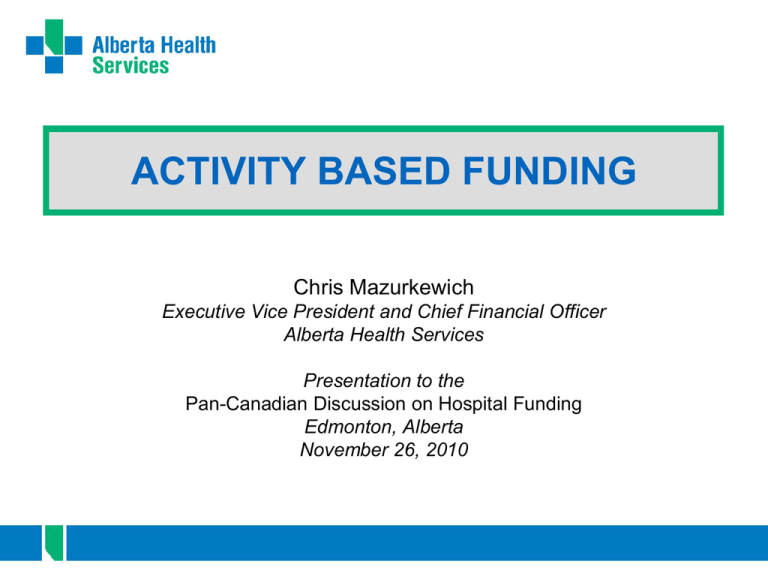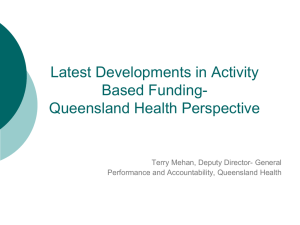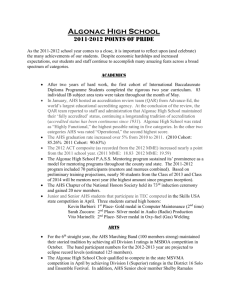ACTIVITY BASED FUNDING
advertisement

ACTIVITY BASED FUNDING Chris Mazurkewich Executive Vice President and Chief Financial Officer Alberta Health Services Presentation to the Pan-Canadian Discussion on Hospital Funding Edmonton, Alberta November 26, 2010 Our History • The creation of Alberta Health Services (AHS) was announced May 15, 2008, bringing together 12 former, separate entities, including nine health regions and three provincial entities. • AHS became a legal entity April 1, 2009 • Ground ambulance service was added to AHS responsibilities April 1, 2009. • Fixed Wing Ambulance and Corrections Services in 2010 2 What is Alberta Health Services’ Comparative Advantage • Intra-provincial learning • Intra-provincial equity • Efficiency and economies of scale/expertise • All of these are ‘works in progress’ • But we are realizing benefits already 3 Transformational Improvement Programs • Guide us in becoming “the best performing, publicly funded, health care system in Canada” • Building on our goals of quality, accessibility and sustainability • Values of Respect, Accountability, Transparency and Engagement • Five areas of focus to prioritize our work over the next five years 4 Improving health for all Albertans Target 2015 Enabling One Health Service Human Resources Finance Improving Access Reducing Wait Times Information Technology Data Integration, Measurement & Reporting Right service Right place Right time Capital Procurement Enabling Our People Working as one Making healthy choices easy choices Right Care in Right Place & Time Best Use of Resources Reducing rework and waste Supporting self management Supportive Environments & Options for Seniors Skilled & Satisfied Workforce Working with partners Engagement Plan (5 strategies) Scope of practice Health and Safety Culture and values Building a Primary Care Foundation Choice and Quality for Seniors Primary care access Early Detection Today 2010 Future ready Growing, Aging , & Diverse Populations Disparities in Health The chronic disease tsunami Waiting for Service Practice Variation Limited options for Seniors Effort and resource duplication Workforce misalignment At home Management & Treatment In the community Self Management Mental Health Staying Healthy, Improving Population Health 5 Plans, Reporting and Accountability Strategic Direction (3rd quarter) Measures reported in Quarterly Public Performance Report Informs Refresh (along with review of health needs etc.) Annual Review of Risk (3rd quarter) Increases likelihood of achievement Increases likelihood of achievement via Performance agreements Strategic Health Plan (TIPs) Individual Performance Agreements Operational Business Plan/Budget (1st quarter) (4th quarter) 6 ACTIVITY BASED FUNDING 7 What is Activity Based Funding? • A way of allocating a (capped) provincial budget – Funding based on price per standard unit of service – Utilizes price-setting, quotas, bonuses, and deductions to create incentives – Beyond creating incentives for higher efficiency (sustainability), need to incorporate measures to ensure quality and access are appropriate • “The money follows the patient” – Uncapped payment per weighted patient? • Maybe a combination of capped and uncapped payment 8 Some ‘theory’ about activity based funding Population Expenditure = Size of Utilization (weighted, Rate (conditions needs x per person X adjusted) admissions population per condition) Population Funding x Services/ Casemix x Admission x How successful have any entities been in managing this? Cost/Service /Quality (eg days, tests) Regional Health Authority/LHIN etc Funder Who allocates funding to hospitals on different bases Activity-based Funding ABF Funder Hospital + Residual (perverse incentive risk) 9 Some ‘theory’ about activity based funding Population = Expenditure Size of (weighted, x needs adjusted) population Utilization Rate (conditions per person X admissions per x Casemix x Cost/Service /Quality Services/ x (eg days, Admission tests) condition) Hospital Who controls this? How much of our variation problem relates to this or cost control? Different levers for two components Conditions per person: hard to influence Admissions per person: also hard to influence Who controls this? How much of our variation problem relates to this or cost control? 10 Policy Objectives of ABF • Some of the policy objectives of ABF are: – Management of prices, volumes and location of service for equitable access and long term sustainability – utilization rate and price? – Meet established standards and quality – incentives? – Increase access through incentives to efficient providers – increase service volumes – Meet regulatory requirements such staffing ratios in long term care – Intra-provincial equity e.g. 17+ ways to fund long term care to a single funding methodology 11 ABF Roadmap for Alberta • Long Term Care – Started implementation April 1st, 2010 – Complete Phase in over 6 years although for AHS facilities 2 years phase in. • Supported living next – From 1 April 2011 • Acute Care • Home Care, Mental Health follow 12 Implementation Approach • LTC implementation – Engagement of all stakeholders – AHW, AHS, Operators, Associations (e.g. ACCA) in developing funding template and transition strategy – Engaging Researchers – U of A School of Nursing, U of C, Inter RAI and CIHI – Development of quality indicators through Seniors Strategy – Keeping political balance through regular meetings and information sessions – Clear articulation of Vision and Work plan – ABF Charter and Project Plan signed of by all stakeholders – Bi-weekly meetings with President & CEO, EVP & CFO, EVP – Seniors, and ABF Team 13 Engagement is Critical • Management and clinician (re)training important • Management and clinician involvement important • Simplicity and transparency a major advantage of case mix-based funding Be clear about behavioral responses intended Avoid conflicting incentives • Audit essential to integrity of system 14 Lessons Learnt • Data availability and quality – organizations planning to implement ABF must focus on how data is collected and entered into systems – training and support for front line staff essential • Engagement of stakeholders – it is never enough – one on one meetings to mitigate political and operational risk • Balance implementation approach with practical applicability e.g. 6 year phase in sounds good on paper but not for those who will get extra funding – they want it NOW! • Need dedicated support from Operations, Strategy, Finance – eases implementation • Strong project framework and focus required • Must have a way to leverage strengths from external organization and universities 15 Lessons Learnt • Expertise (either internal or external) – for AHS Dr. Stephen Duckett critical resource • Knowledgeable staff – Economists, Finance, Policy, Strategy, Clinicians • Have clear goals and linkage to organizational strategy • Develop common language and terms so that people clearly understand the message – too many acronyms • Common IT systems important but should not be used as an excuse for not moving forward 16 QUESTIONS? 17











